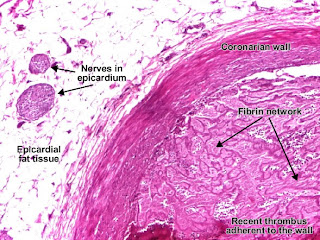Patholgy Slides : Cardiovascular pathology
Patholgy Slides : Cardiovascular pathology
اضغط على الصورة للتكبير -ـ Click on image to enlarge size
Coronary atherosclerosis - fibro fatty plaque
Coronary artery with atherosclerosis (fibro-lipid or fibro-fatty plaque). The atheromatous fibro-fatty plaque is characterized by the accumulation of lipids in the intima of the arteries, narrowing the lumen and compressing the muscular layer. Beneath the endothelium it has a "fibrous cap" covering the atheromatous "core" of the plaque, which consists in cholesterol, cholesterol esters, fibrin, lipid-laden cells (macrophages and smooth muscle cells), proteoglycans, collagen, elastin and cellular debris. The cholesterol crystals form empty, needle-like clefts. At the periphery of the plaque are "foamy" cells and capillaries. (H&E, ob x4)
ـــــــــــــــــــــــــــــــــــــــــــــــــــــــــــــــــــــــــــــــــــــــــــــ
Coronary atherosclerosis - the fibrous plaque with calcification
Coronary artery with atherosclerosis (fibrous plaque). The atheromatous fibrous plaque is localized in the intima of the artery, beneath the endothelium, producing the thickening of the wall and, secondary, the narrowing of the lumen and the atrophy of the muscular layer by compression. The fibrous plaque contains collagen fibres (eosinophilic), precipitates of calcium (hematoxylinophilic) and rare lipid-laden cells. (H&E, ob. x4)
ــــــــــــــــــــــــــــــــــــــــــــــــــــــــــــــــــــــــــــــــــــــــــــــــــ
Recent coronary thrombosis
Thrombosis : recent thrombus in a coronary artery (branch in the epicardium) : The arterial lumen is completely obstructed by a recent thrombus - fibrin network (pink) containing red blood cells and platelets. The thrombus is developed on an ulcerated atherosclerotic (fibrous) plaque and is adherent to the arterial wall. (H&E, ob. x4)
ـــــــــــــــــــــــــــــــــــــــــــــــــــــــــــــــــــــــــــــــــــــــــ
Acute myocardial infarct
Myocardial infarct - circumscribed area of ischemic necrosis - coagulative necrosis. In the first 12 - 24 hours, myocardial fibers are still well delineated, with intense eosinophilic (pink) cytoplasm, but lost their transversal striations and the nucleus (left side of the picture). Notice a few myocardial fibers showing hypertrophy (increased size of the fiber, irregular shape of the nuclei). (H&E, ob. x20)
Recent myocardial infarct (in the first 12 - 24 hours): myocardial fibers are still well delineated, with intense eosinophilic (pink) cytoplasm, but lost their transversal striations and the nucleus. The interstitial space may be infiltrated with red blood cells. Make the distinction between interstitial leucocytes (small, outside the myocardial fibers) and the myocardial nucleus (should be central and unique, but is absent here) ! (H&E, ob. x10)
Recent myocardial infarct (first 24 hours) (detail). (H&E, ob. x20)
ــــــــــــــــــــــــــــــــــــــــــــــــــــــــــــــــــــــــــــــــــــــــــــ
Myocardial infarct healing
Myocardial infarct (healing commencing) - between 5th and 10th day. In area of coagulative ischemic necrosis, myocardial fibers preserve their contour, but the cytoplasm is intensely eosinophilic and transversal striations and nuclei are lost. The interstitium of the infarcted area is initially infiltrated with neutrophils, then with lymphocytes and macrophages, in order to fagocitate the myocyte debris. The necrotic area is surrounded and progressively invaded by granulation tissue which will replace the infarct with a fibrous (collagenous) scar. (H&E, ob. x4, multifield digitally composed picture)
ــــــــــــــــــــــــــــــــــــــــــــــــــــــــــــــــــــــــــــــــــــــــــــــــــــــــــــ
Hyaline arteriolosclerosis (Benign nephrosclerosis)
In benign hypertension, hyaline (pink, amorphous, homogeneous material) accumulates in the wall of small arteries and arterioles, producing the thickening of their walls and the narrowing of the lumens. Consequent ischemia will produce tubular atrophy, interstitial fibrosis, glomerular alterations (smaller glomeruli with different degrees of hyalinization - from mild to sclerosis of glomeruli) and periglomerular fibrosis. (Hematoxylin-eosine, ob. x10)
ــــــــــــــــــــــــــــــــــــــــــــــــــــــــــــــــــــــــــــــــــــــــــــــــــــــــ
Acute viral myocarditis
Myocarditis is an inflammation of the myocardium. Acute viral myocarditis is produced most often by Coxsackie B virus and echovisuses. Myocardial interstitium presents an abundant edema and inflammatory infiltrate, mainly with lymphocytes and macrophages. Focal destruction of myocytes may be present, generating loss of contractile function of the myocardium. (H&E, ob. x10)
ـــــــــــــــــــــــــــــــــــــــــــــــــــــــــــــــــــــــــــــــــــــــــــــــــ
Ischemic fibrosis of myocardium (diffuse ventricular myocardial fibrosis)
Diffuse myocardial fibrosis (Ischemic fibrosis of the myocardium) (Simionescu trichromic staining, ob. x4) : myocardial cells (red) intermingled with collagen-rich fibrosis (blue) which completely replaced the necrotic myocardial cells. Capillaries (with yellow-orange red blood cells) within fibrosis remained from repair by connective tissue process.
Diffuse myocardial fibrosis (Ischemic fibrosis of the myocardium) (Simionescu trichromic staining, ob. x10) : viable myocardial cells (red) with nuclei (brown) surrounded by collagen-rich fibrosis (blue). Fibrosis completely replaced the necrotic myocardial cells. Capillaries (with yellow-orange red blood cells) within fibrosis remained from repair by connective tissue process.
ـــــــــــــــــــــــــــــــــــــــــــــــــــــــــــــــــــــــــــــــــــــــــــــــــــــــ

+-+Copy+-+Copy+-+Copy.jpg)











